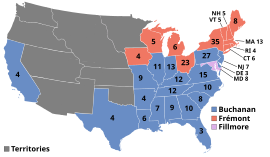Presidential election in the United States 1856
| ‹ 1852 • |
|||||||||||
| 18th presidential election | |||||||||||
| November 4, 1856 | |||||||||||
|
|
|||||||||||
| Democratic Party | |||||||||||
| James Buchanan / John C. Breckinridge | |||||||||||
| electors | 174 | ||||||||||
| be right | 1,836,072 | ||||||||||
|
|
45.3% | ||||||||||
| Republican Party | |||||||||||
| John C. Frémont / William L. Dayton | |||||||||||
| electors | 114 | ||||||||||
| be right | 1,342,345 | ||||||||||
|
|
33.1% | ||||||||||
| Know-nothing party | |||||||||||
| Millard Fillmore / Andrew Donelson | |||||||||||
| electors | 8th | ||||||||||
| be right | 873.053 | ||||||||||
|
|
21.5% | ||||||||||
|
|
|||||||||||
| Election results by state | |||||||||||

|
|||||||||||
|
19 states
Buchanan / Breckinridge |
11 states of
Frémont / Dayton |
||||||||||
|
1 State of
Fillmore / Donelson |
|||||||||||
|
|
|||||||||||
| President of the United States | |||||||||||
The 1856 presidential election in the United States took place on November 4, 1856 . It was the 18th election of the President of the United States . The Democrat James Buchanan won against the newly formed Republican Party candidate , John Charles Frémont , and the Know-Nothing / American Party candidate, Millard Fillmore .
Nominations
The Democrats passed the incumbent President Franklin Pierce on their nomination . In the 17th ballot, Pennsylvania Senator James Buchanan prevailed as a compromise candidate. His fellow candidate was John Cabell Breckinridge from Kentucky .
Among the Republicans, the explorer John Charles Fremont won the race for the nomination against the New York Senator William H. Seward . Former Senator William Lewis Dayton from New Jersey stood with him .
The American Party nominated former Whig President Millard Fillmore, with Andrew Jackson Donelson of Tennessee as a candidate for the vice presidency.
Election campaign
The Republican election campaign was directed against the "destruction of Republican values" by the incumbent Democratic government of Pierce through measures such as the Kansas-Nebraska Act , which let new states decide on their status as free or slave states, and against the aspired annexation of Cuba ( see Ostend Manifesto ).
The Democrats warned that a Republican election victory would lead to secession of individual states and to civil war, which should prove to be true after the next election (see Civil War ).
The Know-Nothing or American Party campaigned for the fight against immigration, especially from Catholic countries, as well as the introduction of stricter naturalization laws. It also attracted southerners and northerners who were concerned about the threat of division in the country.
choice
Fremont received just 600 votes in the southern states, but won most of the states in the northeast and north. Illinois , Indiana , Iowa , New Hampshire, and Ohio were particularly controversial between Buchanan and Fremont . Fillmore was able to win a particularly large number of votes in the "border states" between north and south, including Kentucky , Maryland (which he won), Missouri and Tennessee , but also set an example in states like Louisiana and Georgia . In the populous state of Pennsylvania as well as in California , Illinois and New Jersey , Buchanan was able to win with a simple majority thanks to the triple candidacy.
Buchanan won 174 electoral votes, 25 more than it took to prevent the House of Representatives from going through the 12th Amendment . His winning of the states of Pennsylvania (27 electors), Indiana (13) and Illinois (11) was decisive. Overall, his victory was quite comfortable, but Fremont was able to impressively underline the potential of the only two-year-old Republican Party. With the departure of the American Party in the subsequent elections in 1860 and the split in the Democratic Party, the way was paved for Abraham Lincoln's election victory .
At 79%, the turnout was the fourth largest in presidential elections to date.
Result
| candidate | Political party | be right | electors | |
|---|---|---|---|---|
| number | percent | |||
| James Buchanan | Democrats | 1,836,072 | 45.3% | 174 |
| John Charles Frémont | republican | 1,342,345 | 33.1% | 114 |
| Millard Fillmore | Know-nothing | 873.053 | 21.6% | 8th |
| total | 4,054,647 | 99.9% * | 296 | |
* to 100% missing percent: invalid votes / other candidates
literature
- Donald Richard Deskins, Hanes Walton, Sherman C. Puckett: Presidential Elections, 1789-2008: County, State, and National Mapping of Election Data. University of Michigan, Ann Arbor 2010, ISBN 978-0-472-11697-3 , pp. 155-166 (= Chapter 20: James Buchanan's Election. ).
Web links
Remarks
- ^ Jean H. Baker: James Buchanan. (= The American Presidents Series . Ed. By Arthur M. Schlesinger , Sean Wilentz . The 15th President ). Times Books, New York City 2004, ISBN 0-8050-6946-1 , p. 72.



